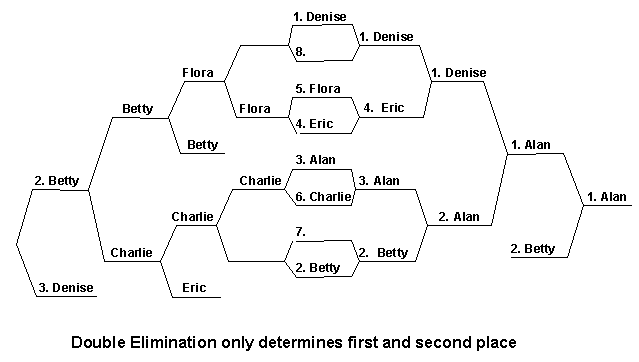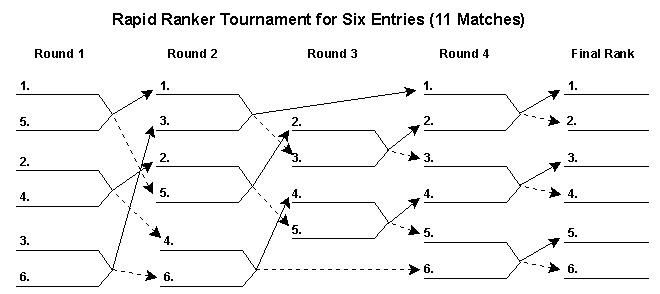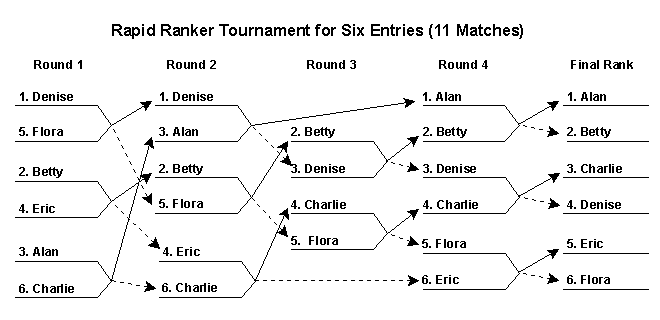
April 28, 2005
©2006 by John P. Pratt. All rights Reserved.
A new tournament promises to be more fun than the single or double elimination because most contestants play four matches, all have a big "final" match, and all are ranked. More will feel like winners instead of losers because half will win their final match.
There are a variety of tournament formats available to the accommodate various needs, such as the number of entrants, limited resources, and availability of pre-tournament rankings. Three classic formats are the Single Elimination, Double Elimination and Round Robin. The Single Elimination handles the case of many contestants, limited resources and good preliminary ranking. At the other extreme, the Round Robin is best with few entrants and it requires no preliminary ranking in order to produce a perfect final ranking of all contestants. Its problem is that the number of matches required skyrockets with each new entry. The intermediate cases are usually handled by the Double Elimination tournament, which always determines first and second place correctly, and third place too if seeded well, in only twice as many matches at the Single Elimination.
This article introduces the Rapid Ranker, a new tournament invented by the author and described here for the first time. It is designed to entirely replace the Double Elimination. Its principal feature is that in the same number of matches, it will rank all entrants rather than merely the top three. With good seeding the final rank is perfect; with no seeding it still does an excellent job. The new Rapid Ranker format will hopefully even rival the Round Robin in many cases, because the ranking is nearly as good in far fewer games. Most important is that more contestants will have more fun and a successful experience because most will play four matches instead of only two, and half will win their final match. The lower players also want to be ranked and feel as important as the top players.
| Single Elimination | Double Elimination | Rapid Ranker | Round Robin | |
| Total Matches | 8 | 15-16 | 16 | 36 |
| Number Ranked | 1 | 2 | 9 | 9 |
| Matches per Entry | 1-4 | 2-7 | 3-4 | 8 |
Number Ranked. The Single Elimination really only determines first place, and even for that result one must assume that if contestant A can beat B, and B can beat C, then A can defeat C and hence they do not need to play. That is true in some sports more than others. In table tennis, for example, where there are many styles and varied equipment allowed, it is often the case that C can nearly always defeat A. The Round Robin determines all six rankings perfectly, given that there is a way to break the three-way tie that occurs when C does indeed defeat A. The Double Elimination tournament only determines first and second place, unless seeded well in which case the bronze medal usually goes to the right entrant. The power of the Rapid Ranker is that ranks all entries very well, provided there is an approximate initial ranking (seeding) available. It is not always perfect, but in about the same number of matches as the Double Elimination, it usually determines third place equally well, along with all of the other places.
Morale. Those lower rankings are a very important consideration for developing players who might be very pleased to know they placed fourth out of six. In the Rapid Ranker, the bottom two entrants get their own "final," which can be just as important to them as the medals match for the stronger players. The effect on morale here cannot be overstated. How many players have quit their sport after discovering they are "losers" who are knocked out of the tournament on their first one or two matches? Both the Single and Double Elimination can make everyone feel like a "loser" except for the first place winner. How often have we heard a TV interviewer ask the silver medalist how they felt about "losing"? On the other hand, it can be exhilarating to win a final match to place fifth out of six, perhaps in a higher division than one expected to qualify for.
Matches per Entry. The contestants all came to play, but the Single Elimination only guarantees one match each, and the Double Elimination guarantees two, which still is often not enough to justify entering a tournament. The Rapid Ranker provides four matches for most contestants, twice as many as the Double Elimination. A serious problem with the Double Elimination is that some players have to play far too many matches. In this example of nine entrants, a player working up in the "loser" bracket may have to play seven matches to finally defeat the leader of the winning side. He often becomes exhausted while many players only get two matches. The Rapid Ranker solves that problem by spreading out the matches among more contestants so that most get four.
| Number of Entrants | Single Elimination | Rapid Ranker | Double Elimination | Round Robin |
| 2 | 1 | 1 | 2-3 | 1 |
| 3 | 2 | 3 | 4-5 | 3 |
| 4 | 3 | 5 | 6-7 | 6 |
| 5 | 4 | 8 | 8-9 | 10 |
| 6 | 5 | 11 | 10-11 | 15 |
| 7 | 6 | 12 | 12-13 | 21 |
| 8 | 7 | 15 | 14-15 | 28 |
| 9 | 8 | 16 | 16-17 | 36 |
| 10 | 9 | 19 | 18-19 | 45 |
| 11 | 10 | 20 | 20-21 | 55 |
Equal number of matches. Nearly all contestants should play nearly the same number of matches.
Gold, Silver, Bronze. It is desirable to give a prize to the third place winner also. They often have a long battle just to play for second place, and deserve recognition. The main reason that many tournaments award only first and second is that they don't even know who placed third.
Everyone Ranked. Ranking every contestant is beyond the scope of nearly every tournament format, but it is clearly desirable. In the table tennis club I attend, players compete vigorously to move up from 19th place to 18th.
Any Contestant Might Win. While it is often important to seed tournaments by using preliminary ranking to determine pairings, it is important that no contestant be prohibited from winning because of poor seeding.
Simple Format. Contestants need to be able to understand the consequences of winning or losing each match. Often they are the ones filling out the score sheet and determine pairings. After a loss, it is useful to see the path to success from that point on. Note that the Round Robin is poor at indicating the consequences of losing one match because the final result may be determined by a tie breaking procedure at the end.
No single Match overly important. This requirement is less precise, but the idea is that one bad match should not destroy a player's to at least medal. The Single Elimination tournament ignores this requirement entirely, and the Double Elimination over-compensates by allowing the top two opponents to play the best two out of three matches. In the Rapid Ranker, if the first or second seeds lose the first match, they can still finish third in most cases, which seems to be a good compromise.
Not Meet the Same Opponent Twice. The format should avoid letting opponents compete against each other more than once.
Early Matches are Warm-Ups. The early matches should not pair two very closely matched opponents, and all the "medal round" matches should come at the end.
Lower-ranked players compete to play better players. Often a real incentive to defeat an opponent is just to have the privilege of next playing one of the big-name players.
 |
Let's suppose there are six contestants whose ability happens to coincide with the alphabetic order of their names. That is, suppose Alan can beat Betty, who can always defeat Charlie, who can beat Denise, who can beat Eric, who can beat Flora. Suppose that Charlie and Alan have improved a lot since the preliminary ranking was done, and that Denise is overrated. Let's say the pre-tournament ranking is 1) Denise, 2) Betty, 3) Alan, 4) Eric, 5) Flora and 6) Charlie. Suppose they play a Single Elimination tournament, seeded in that order. As can be seen from the illustration, Alan, who is best will win. That will be true no matter what position he starts from, so the Single Elimination correctly picks the top contestant, even if poorly seeded, or not seeded at all. But notice that it is Denise who would be given the second place trophy because she played Alan in the championship match. But she does not deserve the trophy because she is only the fourth best contestant.
 |
This problem of determining second place is well known, which is what led to the development of the Double Elimination tournament. It is essentially two single elimination tournaments back to back. That is, all who have lost one match are entered into another single elimination to determine who is second place. That always works correctly, but it is important to not that it fails about half the time to correctly determine third place. Looking at the next illustration, we see that Betty is awarded second place, but her last match in the loser's tournament was with Denise, who would be given third place. But Charlie is really the third place contestant; he just didn't get a chance to prove it by playing Denise. Thus, the Double Elimination tournament only determines the top two places.
For comparison, the Round Robin always perfectly determines all places, even if randomly seeded, as shown in the following score sheet.
| Name | Denise | Betty | Alan | Eric | Flora | Charlie | W-L | Rank |
| 1. Denise | — | L | L | W | W | L | 2-3 | 4 |
| 2. Betty | W | — | L | W | W | W | 4-1 | 2 |
| 3. Alan | W | W | — | W | W | W | 5-0 | 1 |
| 4. Eric | L | L | L | — | W | L | 1-4 | 5 |
| 5. Flora | L | L | L | L | — | L | 0-5 | 6 |
| 6. Charlie | W | L | L | W | W | — | 3-2 | 3 |
So now let us see just how the Rapid Ranker accomplishes this miracle of ranking all contestants so quickly, while also fulfilling nearly all of the above desirable criteria.
Given a preliminary ranking, let us now look at the details of how the Rapid Ranker works. There is a special pairing sheet for each number of entries from 5 to 11. If there are only 3-4 entries, then the Round Robin should be used. The Rapid Ranker system works best for 5-9 players per division. With more than nine, there is a chance that the top player could have a bad first match and not be able to medal at all.
When two players compete, if the lower-ranked player prevails, the two swap places. That is, if the player ranked #3 is defeated by #6, then the latter player because the new #3 player and the other becomes #6. Let us look at an example of a Rapid Ranker tournament with six entries.

The entries are paired in the left hand column on the lines indicating their preliminary rank. After they play, the winner moves up following the solid lined arrow, and the loser moves down along the dotted line. Note that the place they arrive has the same two ranking numbers as before, but that the names written in will be swapped in the case of an upset. The consequence of a loss is immediately clear by following the possible future arrows. For example, if the number 2 player loses the first match, the highest medal attainable will be the bronze. Knowing that up front may help the adrenalin flow even in the first match.
Although every match has serious consequences, note that the first three matches fulfill the "warm up" requirement above. That is, each match for the top three is with a contestant ranked at least two lower. On the other hand, it gives the lower players a good chance to move up. In the second round player 6 has a chance to move up to be 4, and player 3 also gets to attempt to move into the top spot. In the third round, there is a special "pre-final" match for 2 vs 3 and 4 vs 5, designed to help contestants advance one more place. The comes the "finals" match between 1 and 2, 3 and 4 (for the bronze), and 5 and 6. Thus, in many case, the player finally ranked 1 will have defeated 2, who defeated 3, who defeated 4, who defeated 5, who defeated 6. Thus, players will know they have been accurately ranked in such a few matches. Also, contestants got to play those ranked near themselves: the top entry played 2, 3, and 5, while the bottom entry played 5, 4, and 3. But the fun factor is obvious here because half of the contestants will win their final match, ending on a positive note. The bronze medal will now really be worth something, because it came from a playoff match, rather than being awarded for a loss.

Now let us consider the same example of our six players: Alan, Betty, Charlie, Denise, Eric and Flora. They are seeded and play as described above. You can see the tournament sorting them out into the correct order with each round. Note how the tournament ends up ranking all six correctly in the perfect order. Thus, the approximate preliminary ranking was corrected by the tournament, and in only 11 matches. The Rapid Ranker selected those key matches from the 15 possible in a Round Robin and correctly determined the final ranking. It will not always give a perfect ranking, but it will be rare than anyone ends up more than one position from the correct place.
There are cases in the Rapid Ranker in which two contestants may meet twice. It will not happen often, nor if seeded well, but when it does happen it is usually necessary because someone is moving up and may need to verify their claim by defeating someone twice. This example was the more typical case in which no two contestants played each other twice.
Pairing Forms. The Rapid Ranker tournament requires a different pairing scheme for each number of entrants. There are seven in all, one each for 5 to 11 entrants. These forms are available for nominal cost by contacting me at the following address:
Dr. John P. Pratt
P.O. Box 752
Orem, UT 84059